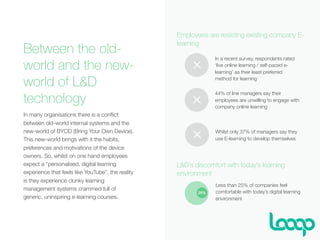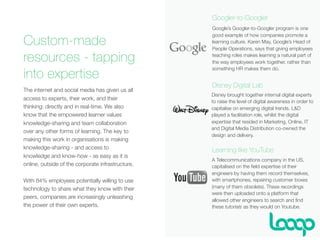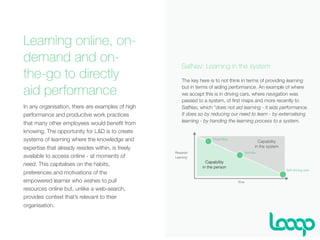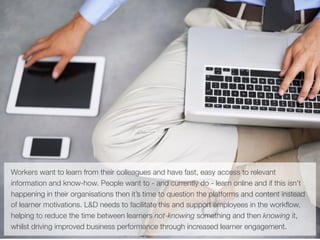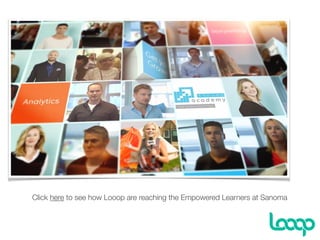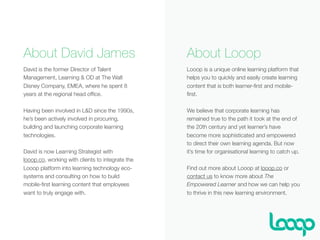We Are All Empowered Learners
- 2. v Technology has put instant knowledge and know-how in the hands of the learner, which has changed everything for the Learning & Development department today.
- 3. v Workplace learning has changed dramatically in the past ten years and technology has been the primary driver of that change. However, it has not necessarily been learning solutions supplied by organisations that have been the game-changer. The way that technology has enabled workers to self-direct their learning has been the significant factor. Whether it’s been fully acknowledged or not, this has dramatically changed the learner’s relationship with L&D.
- 4. By capitalising on recent insights into today’s learners - their motivations, habits and preferences - L&D can drive improved business performance through increased learner engagement.
- 5. The Empowered Learner Hyperconnected & self-directed
- 6. 91% of smartphone users will turn to their devices for ideas while completing a task Searches related to "how to" on YouTube are growing 70% each year More than 70% of employees use search engines to learn what they need for their jobs; will unlock their smartphones 9 times an hour; and watch videos for no longer than 4 minutes Modern online learning habits Research shows us that employees are accessing the learning they need differently from how they did just a few years ago. Most are now looking for what they need away from their organisation’s Learning & Development channels. For example, it’s recognised that more than 70% of employees will now use web searches to learn what they need for their jobs and are increasingly turning to their mobile devices to find just-in-time, immediate answers to their unexpected problems. The way people are interacting with their mobile devices provides further insight into modern habits.
- 7. Employees are learning from more varied sources Research is showing that employees are developing ‘continuous learning’ habits whilst drawing from various sources to do so. Furthermore, the involvement of the organisation and L&D is a small proportion of this continuous process as people explore and discover new trusted sources Workers invest more than 14 hours a month, on average, learning on their own, but just two to three hours on employer-provided training Employees spend up to 5x more time learning from their own sources 2.7 14.4 Self learning Employer provided 77% 23% Company Courses Articles, Videos & Books Employees rely disproportionately on self-direction vs company L&D 23% of workers say they completed a course of any kind in the last 2 years, whereas more than 70% learned something for their job from an article, video or book in the last 24 hours
- 8. Company training is the lowest rated way to learn The relationship between L&D and the empowered learner has changed, with direct access to experts, knowledge and learning freely available online. This was seen starkly in a recent survey to rate the importance (value/ usefulness) of 10 different ways of learning in the workplace. It was revealed that ‘web- searching for resources’ came second only to ‘knowledge sharing within the team’. ‘Company training/E-learning’ was rated least important - and ranked 10 out of a possible 10. 87%Knowledge sharing within teams 79% 79% Company Training & e-Learning Web-searching for resources General conversations and meetings 37% How important (useful or valuable) are the following ways for you to learn in the workplace?
- 9. The Modern Learning Environment From ‘push’ to ‘pull’ “Being constantly connected has trained us to expect immediacy and relevance in moments of intent - the I-want-to-know, I-want-to-go, I-want-to-do moments.” Think With Google, May 2015
- 10. Traditional L&D is absent at the moment of need Modern learning habits, facilitated by web- search, have prompted and accelerated the move away from ‘push’ towards ‘pull’ learning. The empowered learner will now search for what they need, online and at their moment of need. Often they’ll search just before their moment of apply whilst remaining within their workflow. However, web-searches take employees outside of their organisation where the answers they discover lack the appropriate context. This is despite the knowledge and know-how often residing within the organisation. Moment of Apply New When learning how to do something for the first time Solve When problems arise, or things don’t work the way they were intended More When expanding the breath and depth of what’s been learnt Change When learning new ways, which requires a change to skills deeply ingrained Worker’s moment of need Traditional approaches to training and e-learning require scheduled time for leaving the workflow to learn. The application of which will take place at an undetermined time in the future. Today's world of work often requires people to remain in the workflow and learn something (New or More) right at the moment they need it - rather than take a ‘course’. Work demands and web-search have determined that people “learn in real-time, whilst on the job, at the moment of apply.”
- 11. ‘Pull’ increases the influence and retention of learning Whilst traditional ‘push’ learning, in the form of classroom and e-learning courses, often anticipate the moments of need, it may be a number of weeks or months before application. By which time, the opportunity to influence application to any real effect has long gone. However, when the empowered learner searches online for information and know-how they bring motivation and immediacy to the learning, which increases the likelihood of applying that learning and, therefore, its retention. Learners forget almost everything from ‘push’ learning unless applied quickly The Forgetting Curve11 The decline of memory retention over time Memory 100% 50% 75% 25% 1day 7days 1month 14days 1hour When learning is ‘self-directed’, the application increases significantly 53% 53% of people quickly put into practice their own self- directed learning
- 12. Between the old- world and the new- world of L&D technology In many organisations there is a conflict between old-world internal systems and the new-world of BYOD (Bring Your Own Device). This new-world brings with it the habits, preferences and motivations of the device owners. So, whilst on one hand employees expect a “personalised, digital learning experience that feels like YouTube”, the reality is they experience clunky learning management systems crammed full of generic, uninspiring e-learning courses. Employees are resisting existing company E- learning In a recent survey, respondents rated ‘live online learning / self-paced e- learning’ as their least preferred method for learning 44% of line managers say their employees are unwilling to engage with company online learning Whilst only 37% of managers say they use E-learning to develop themselves L&D’s discomfort with today’s learning environment 25% Less than 25% of companies feel comfortable with today’s digital learning environment
- 13. The Modern L&D Function From courses to resources Famously, Einstein reached for a directory when asked for his telephone number. "You don't remember your own number?" he was asked. "No," Einstein answered. "Why should I memorise something I can so easily get from a book?”
- 14. Not-knowing 90% of what’s needed for the job If knowledge workers only retain 8-10% of what they need to know to do their jobs (down from 75% in 1986) how well-equipped are they to find the other 90 percent when they need it in your organisation? To be clear, this isn’t about retaining information after a training session. This is not knowing 90% of what they need for their jobs - in totality. It’s easy to see why employees and organisations benefit from easy access to the right resources at the right time. This approach immediately makes learning more relevant, personalised and effective. Learners are encouraged to learn when they need to learn, rather than for a future or past need. 90% 10% Retained knowledge Knowledge not held By 2006, knowledge workers were retaining only between 8-10% of the knowledge they needed to do their jobs. 25% 75% Retained knowledge Knowledge not held In 1986, knowledge workers retained 75% of what they needed to know for their job Knowledge workers used to retain most of what they needed for their job Knowledge workers now only retain up to 10% of what they need to know
- 15. Custom-made resources - tapping into expertise The internet and social media has given us all access to experts, their work, and their thinking: directly and in real-time. We also know that the empowered learner values knowledge-sharing and team collaboration over any other forms of learning. The key to making this work in organisations is making knowledge-sharing - and access to knowledge and know-how - as easy as it is online, outside of the corporate infrastructure. With 84% employees potentially willing to use technology to share what they know with their peers, companies are increasingly unleashing the power of their own experts. Disney brought together internal digital experts to raise the level of digital awareness in order to capitalise on emerging digital trends. L&D played a facilitation role, whilst the digital expertise that resided in Marketing, Online, IT and Digital Media Distribution co-owned the design and delivery. Google’s Googler-to-Googler program is one good example of how companies promote a learning culture. Karen May, Google’s Head of People Operations, says that giving employees teaching roles makes learning a natural part of the way employees work together, rather than something HR makes them do. Googler-to-Googler Disney Digital Lab Learning like YouTube A Telecommunications company in the US, capitalised on the field expertise of their engineers by having them record themselves, with smartphones, repairing customer boxes (many of them obsolete). These recordings were then uploaded onto a platform that allowed other engineers to search and find these tutorials as they would on Youtube.
- 16. Learning online, on- demand and on- the-go to directly aid performance In any organisation, there are examples of high performance and productive work practices that many other employees would benefit from knowing. The opportunity for L&D is to create systems of learning where the knowledge and expertise that already resides within, is freely available to access online - at moments of need. This capitalises on the habits, preferences and motivations of the empowered learner who wishes to pull resources online but, unlike a web-search, provides context that’s relevant to their organisation. Required Learning Time Capability in the person Capability in the system Road Map Sat Nav Self-driving cars The key here is to not think in terms of providing learning but in terms of aiding performance. An example of where we accept this is in driving cars, where navigation was passed to a system, of first maps and more recently to SatNav, which “does not aid learning - it aids performance. It does so by reducing our need to learn - by externalising learning - by handing the learning process to a system. SatNav: Learning in the system
- 17. Conclusion Reaching the empowered learner
- 18. Workers want to learn from their colleagues and have fast, easy access to relevant information and know-how. People want to - and currently do - learn online and if this isn’t happening in their organisations then it’s time to question the platforms and content instead of learner motivations. L&D needs to facilitate this and support employees in the workflow, helping to reduce the time between learners not-knowing something and then knowing it, whilst driving improved business performance through increased learner engagement.
- 19. Rather than perceiving t h i s n e w l e a r n i n g environment as a threat or insurmountable challenge, L&D can embrace it and carve out its own role in the m o d e r n l e a r n i n g landscape. It’s quicker and easier to do so than is commonly believed…
- 20. 1. Knowledge-Sharing Knowledge-sharing and collaboration are the preferred and most effective development methods so find ways to harness this - on and offline. Empower and trust your sharers. Think: Intuitive and time-friendly
- 21. 2. Performance Support Create and curate performance support that can be pulled at the learner’s moment of need, in a way that replicates how people do this successfully already online. Think: Learner-first and in-the-workflow
- 22. 3. Modern Technology Find the right technology tools that your learners want to engage with and that will reach and support the 21st century employee - both today and for the future. Think: Google and YouTube
- 23. Click the image above to see how Looop are reaching the Empowered Learners at Sanoma
- 24. About David James David is the former Director of Talent Management, Learning & OD at The Walt Disney Company, EMEA, where he spent 8 years at the regional head office. Having been involved in L&D since the 1990s, he’s been actively involved in procuring, building and launching corporate learning technologies. David is now Learning Strategist with looop.co, working with clients to integrate the Looop platform into learning technology eco- systems and consulting on how to build mobile-first learning content that employees want to truly engage with. About Looop Looop is a unique online learning platform that helps you to quickly and easily create learning content that is both learner-first and mobile- first. We believe that corporate learning has remained true to the path it took at the end of the 20th century and yet learner’s have become more sophisticated and empowered to direct their own learning agenda. But now it’s time for organisational learning to catch up. Find out more about Looop at looop.co or contact us to know more about The Empowered Learner and how we can help you to thrive in this new learning environment.
- 25. Get the white paper For the report version of The Empowered Learner - with full referencing - go to the Looop website and download it for free!












